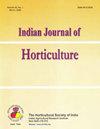In vitro multiplication of peach rootstocks
Q4 Agricultural and Biological Sciences
引用次数: 0
Abstract
The leaf yellowing and senescence during micro-propagation reduces the shoot proliferation rates with every sub-culture in peach rootstock (Prunus spp.). The effect of culture media and supplements on the proliferation of cultures during the micro-propagation of two peach rootstocks ‘Sharbati’ and ‘Flordaguard’ was studied. In both Prunus genotypes, the proliferated cultures decreased from 77.3% and 67.0 % after the first sub-culture to 35.3 % and 27.3 % after the third sub-culture in ‘Sharbati’ and ‘Flordaguard’, respectively. QL medium significantly improved the proportion of proliferated cultures over MS, WPM, DKW and the modified MS media. The highest proliferated cultures (79.0% and 70.7%) and shoot number per culture (4.2 and 3.7) were recorded after the third subculture, in ‘Sharbati’ and ‘Flordaguard’, respectively with QL medium. Both the rootstocks varied in their response to iron chelates. The higher proliferation rates were obtained with MS medium by substituting Fe-EDTA (0.1 mM) with Fe-EDDHA (0.1-0.3 mM) in ‘Sharbati’ and with Fe-Na EDTA (0.1 mM) in ‘Flordaguard’. In‘Sharbati’, the highest proliferated cultures (44.3%) after the third subculture were observed with Fe-EDDHA (0.3 mM). In ‘Flordaguard’, the highest proportion of proliferated cultures (45%) after the third subculture was recorded with Fe-Na EDTA (0.1 mM). Adding silver nitrate (3 mM) improved the shoot proliferation rates to the highest levels (63% and 51%) after third subculture in ‘Sharbati’ and ‘Flordaguard’, respectively. The highest rooting (34.3% and 38.0%) and number of roots per shoot (2.2 and 2.5) were recorded with 3.75 mM of IBA in ‘Sharbati’ and ‘Flordaguard’, respectively.桃砧木的离体增殖
桃源砧木在微繁过程中叶片变黄和衰老,使其每一次继代增殖速率降低。以桃砧木‘夏巴蒂’和‘Flordaguard’为材料,研究了培养基和培养基添加量对其增殖的影响。在两个李基因型中,‘Sharbati’和‘Flordaguard’的增殖率分别从第一次继代培养后的77.3%和67.0%下降到第三次继代培养后的35.3%和27.3%。与MS、WPM、DKW和改良MS培养基相比,QL培养基的增殖比例显著提高。在QL培养基中,‘Sharbati’和‘Flordaguard’在第3次传代培养后,增殖率最高(79.0%和70.7%),每培养芽数最高(4.2和3.7)。两种砧木对铁螯合剂的反应不同。用Fe-EDTA (0.1 mM)代替‘Sharbati’中的Fe-EDDHA (0.1 ~ 0.3 mM),用Fe-Na EDTA (0.1 mM)代替‘Flordaguard’中的Fe-Na EDTA (0.1 mM),在MS培养基中获得了较高的增殖率。在' sharbati '中,用Fe-EDDHA (0.3 mM)进行第三次传代培养后,增殖率最高(44.3%)。在' Flordaguard '中,Fe-Na EDTA (0.1 mM)在第三次传代培养后的增殖比例最高(45%)。在‘Sharbati’和‘Flordaguard’第三代培养后,添加3 mM硝酸银的芽增殖率分别达到最高水平(63%和51%)。‘Sharbati’和‘Flordaguard’在3.75 mM的IBA下生根率最高,分别为34.3%和38.0%,单根数最高,分别为2.2根和2.5根。
本文章由计算机程序翻译,如有差异,请以英文原文为准。
求助全文
约1分钟内获得全文
求助全文
来源期刊

Indian Journal of Horticulture
农林科学-园艺
CiteScore
0.50
自引率
0.00%
发文量
22
审稿时长
4-8 weeks
期刊介绍:
Information not localized
 求助内容:
求助内容: 应助结果提醒方式:
应助结果提醒方式:


